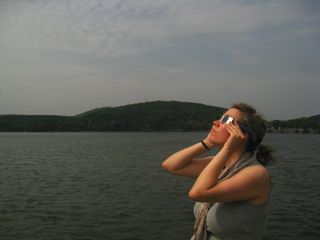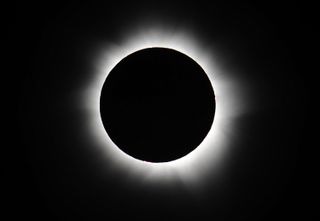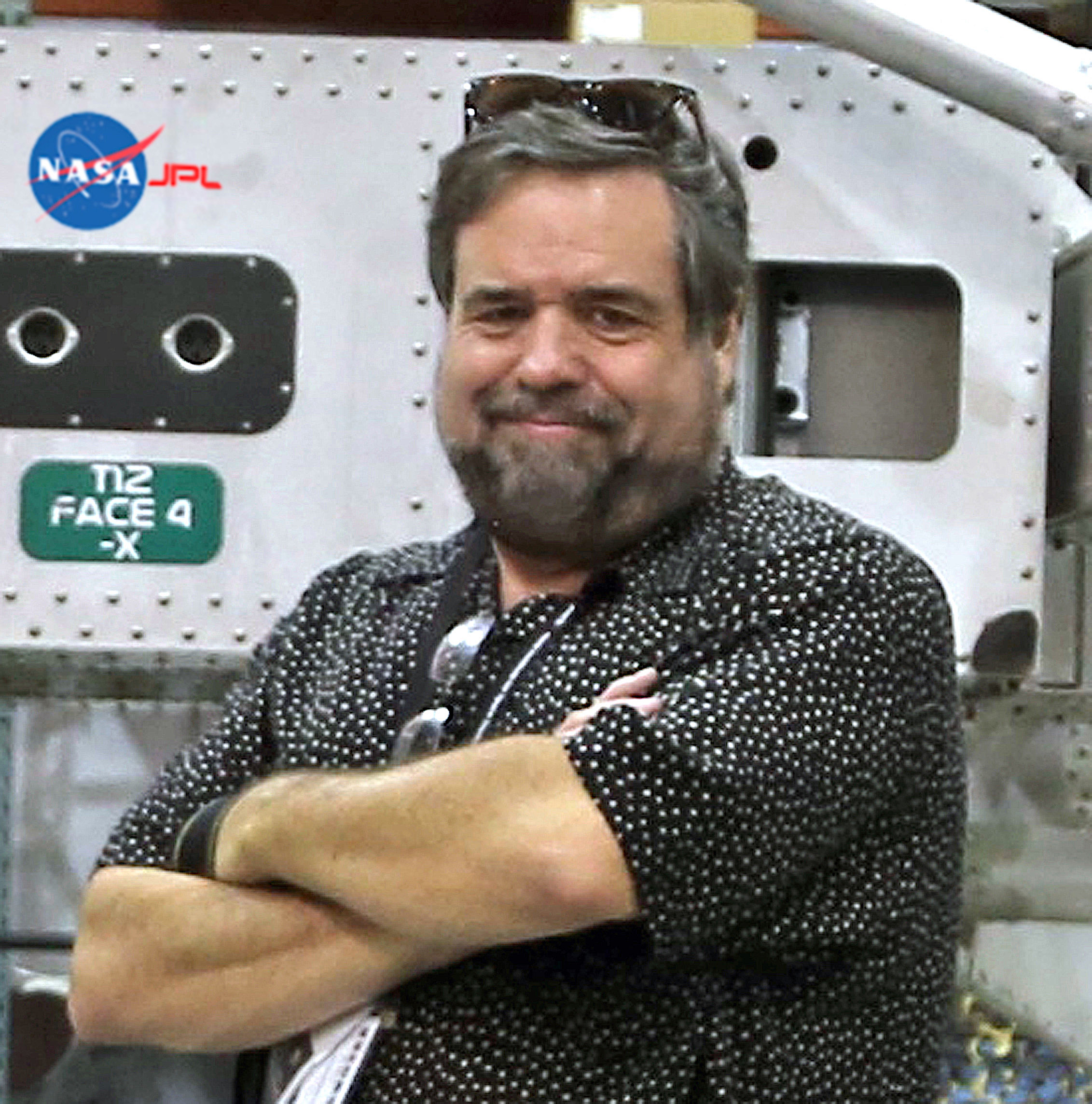
Rod Pyle is a space historian who has worked with NASA at the Jet Propulsion Laboratory and the Johnson Space Center. He has written 10 books on the history and technology of space exploration and science, including "Mars: Making Contact" (Carlton Books, 2016), "Blueprint for a Battlestar" (Sterling Publishing, 2016) and "Amazing Stories of the Space Age" (Prometheus Books, 2017). His newest book, "Space 2.0," will debut in 2018. You can listen to Pyle's podcast about eclipse-viewing safety here. Pyle contributed this article to Space.com's Expert Voices: Op-Ed & Insights.
On Aug. 21, 2017, a total solar eclipse will be visible across the continental U.S., coast to coast, for the first time since 1918. Millions of people will flock to the path of totality to see this magnificent spectacle.
Many millions more will attempt to view the partial phases of the eclipse in other parts of the country. If you are among that group of skywatchers, you may be tempted to take a quick look at the partially eclipsed sun with your naked eye, or to use inadequate gear to view the partial phases.
Don't.
I viewed partial solar eclipses with faulty equipment as a child, and lost nearly half my vision in one eye. Trust me, it's not worth it. And the worst part? There are no pain receptors in your eyes, so you won't know you are damaging them until a few days later when it's too late.[A Solar Eclipse Can Blind You (Read This Before Looking at the Sun!)]
A total solar eclipse occurs when the moon passes between the Earth and the sun, completely blocking out the full diameter of the sun. During this event, if you are within the path of totality (the region that falls inside the moon's inner shadow), the sky darkens and you will be able to see the solar corona, the extended atmosphere of the sun made up of plasma and extending millions of miles beyond the part of the sun that is normally visible to us. Before and after totality, and in a wide area outside the path of totality, you will see partial phases of the eclipse. It's these partial phases that are so potentially dangerous.
If you plan on viewing the total eclipse, you will need to head to the 70-mile-wide path of totality. The partial eclipse begins on the Oregon coast at 9:04 a.m. PDT, and reaches totality at 10:15 a.m. PDT. The shadow will cross the country and totality will end on the shores of Charleston, South Carolina, at 2:47 EDT. NASA and the website eclipse2017.org have interactive maps that provide specific times for the partial and total eclipse start and end in a given spot.
Get the Space.com Newsletter
Breaking space news, the latest updates on rocket launches, skywatching events and more!
You can also visit Space.com for a live solar eclipse webcast, courtesy of NASA, beginning at 12 p.m. EDT (1600 GMT).
Anywhere outside this corridor in North America (as well as some parts of South America, Africa and Europe), you will be seeing some percentage of the sun eclipsed by the moon. It's worth looking at, but only with the utmost care and proper precautions.
My experience with eye damage from the sun

Seeing a total solar eclipse is said to be an astounding event. If you can't make it into the path of totality, viewing the partial phases is also exciting—but not worth losing your eyesight for. It's all too easy to let a moment of temptation lead to a permanent disability.
When I was a young boy in the 1960s, my father bought me an inexpensive telescope that included a solar filter you could screw into the eyepiece. There was a warning printed on the filter to use only for brief periods, but what 8-year-old follows such instructions?
I used the device to view sunspots and partial solar eclipses, without adult supervision, for a few years. By my late 40s, I had vision trouble with my right eye — the same eye I used for viewing the sun. Soon I had cataracts — which were, according to the eye surgeon, the result of exposure to UV light from the sun, greatly accelerated by the use of the inadequate solar filter. I was forced to undergo surgery to replace the lenses in both eyes. And I was lucky; had that little screw-in eyepiece filter cracked during use (a not infrequent occurrence) I would have been instantly blinded by 50-power magnification of direct sunlight.
Other people have similar stories, but they all end with the same result — some kind of permanent eye damage. It doesn’t seem all that serious until your vision begins to gray-out, lose focus and dim; then it really gets your attention.
Finding safe viewing devices

This cannot be stressed enough: Be smart and view the eclipse safely. Even short glances at the sun can cause permanent eye damage. To observe any phase of the eclipse before or after totality — and even right on the verge of it — you need certified eye protection.
There are hundreds of vendors all over the country and online selling "eclipse glasses" and "eclipse viewers," but be wary. You must be sure that the viewing device you buy is rated for safety by the ISO, or International Standards Organization. Their rating, which must be printed on the viewing device, should read "ISO 12312-2." This means that the viewing medium will block all harmful solar radiation and can be used to safely view the sun anytime.
But there are also many unscrupulous parties out there making knockoffs with cheaper materials, and some even have the ISO certification falsely printed on them.
How can you make sure you are getting the real deal?
The only way to be sure that you are protecting your eyes, and those of your family, is to buy your viewing device from a reputable source. See this list of approved manufacturers and vendors created by the American Astronomical Society. Purchasing at a brick-and-mortar supplier is the best bet.
The site also lists a number of reputable online outlets, but unless you can get guaranteed overnight shipping, it's probably too late. Amazon ships quickly, but a search for "eclipse glasses" turns up a wide array of devices that may or may not be safe, though most of the vendors suggest that they are. You must be certain that the device you buy is manufactured by a recognized supplier, is truly ISO-certified and is brand new (eclipse glasses and other sun filters can degrade over time and with use). Also, to be extra sure, check that the devices are shipping from that manufacturer and being fulfilled by Amazon — otherwise, you have no idea what you will actually receive.
Amazon is doing what they can to protect consumers — they recently issued a recall for many eclipse viewers — but they will not catch all offenders. The same holds true for the websites of Walmart, Target, K-Mart and others — small, third-party vendors are selling viewers of questionable quality at highly inflated prices. Don’t take chances — the best way to be sure your viewers are safe is to buy directly from the retailer in a brick-and-mortar outlet.
Note that many public libraries and science museums are giving away free viewers until their supplies are exhausted. These are presumed to be safe for use.
Regardless of where you get your eclipse viewers, check them before use — your view of the sun should be fairly dim, with no lines or bright spots. If this is not the case, toss them and find another pair. The AAS website also has guidelines for how to check if your viewers are safe.
Also, if the plastic lens on a pair of eclipse viewers is creased or scratched, do not use them (even if they are certified safe). And it you have bought safe, certified cardboard viewers, don't put them in a pocket where they may get folded or creased — the lens' surfaces need to be kept flat and non-abraded. This is especially relevant for children — give them the viewers only when you’re ready to supervise their viewing of the sun, and keep viewing periods brief.
If you have not found a pair of eclipse viewers of your own, there’s a good chance someone will lend you a pair for a quick look-- the partial phases change very slowly. Just make sure the viewers are certified and safe.
Alternative ways to view the partial eclipse
The safest and most foolproof way to view a partial phase of the eclipse is with a pinhole projector. These are easy to make and absolutely safe if used properly.
Take a box lid or paper plate and punch a hole through it with a small nail. Then take a second paper plate or piece of cardboard and hold or mount it about 18 to 24 inches from the pinhole. Angle the apparatus so that the pinholed sheet is perpendicular with the light from the sun, and you will see a small image of the solar disk projected onto the second sheet. This is not an image of the hole, but an optical reproduction of the sun's disk.
Do not look at the sun through the pinhole! This is a common misperception of how pinhole projectors work and will blind you. This device is for projection only. Practice with it before the day of the eclipse so you're not fiddling around at the last moment — it takes some getting used to.
Public viewing of the partial eclipse
You can view the eclipse in its partial phases from anywhere in the continental U.S. Many people will be drawn to public viewing events. But again, be careful what devices you use.
If someone has set up a sun projector, that's great — enjoy it. There may be telescopes set up with solar filters offering free viewing, and if they are from a local observatory, university or museum, it is probably safe to view — but no guarantees. If it's just some stranger with a telescope and a filter, you’re taking the chance that they are using something unsafe, and it’s probably not worth the risk. Don't succumb to temptation unless you are comfortable that the filter in use is 100 percent safe.
Viewing totality

If you’re lucky enough to be in the path of totality, you may view the eclipse with the naked eye and even binoculars. But you must be certain to wait until totality and to stop well before the end of totality — sunlight emerging past the moon's disk will be magnified and do damage to your eyes. There are eclipse timer apps available for your smartphone.
Protect your eyes, and supervise your children while viewing any part of the eclipse. Put on eclipse viewing glasses before looking towards the partially eclipsed sun, and remove them after looking away. Do your homework, use only approved viewers, and prepare to enjoy one of nature's greatest spectacles safely.
Follow us @Spacedotcom, Facebook and Google+. Original article on Space.com.
Join our Space Forums to keep talking space on the latest missions, night sky and more! And if you have a news tip, correction or comment, let us know at: community@space.com.

Rod Pyle is an author, journalist, television producer and editor in chief of Ad Astra magazine for the National Space Society. He has written 18 books on space history, exploration and development, including "Space 2.0," "First on the Moon" and "Innovation the NASA Way." He has written for NASA’s Jet Propulsion Laboratory, Caltech, WIRED, Popular Science, Space.com, Live Science, the World Economic Forum and the Library of Congress. Rod co-authored the "Apollo Leadership Experience" for NASA's Johnson Space Center and has produced, directed and written for The History Channel, Discovery Networks and Disney.
